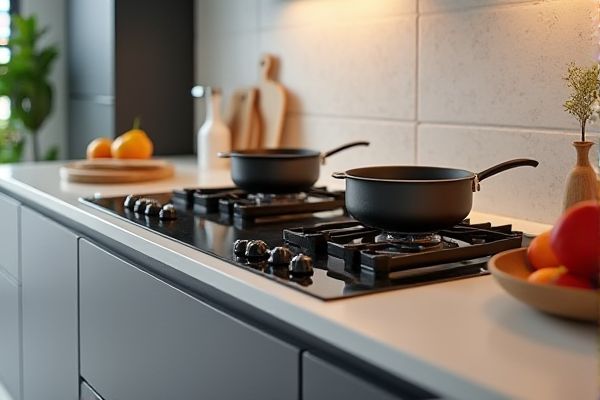
Induction cooktops offer precise temperature control and energy efficiency by directly heating pots through electromagnetic fields, while gas cooktops provide instant heat and visual flame adjustment favored by many chefs. Discover which cooktop suits Your cooking style best by exploring the detailed comparison in the rest of the article.
Table of Comparison
| Feature | Induction Cooktop | Gas Cooktop |
|---|---|---|
| Heat Source | Electromagnetic induction | Open flame from natural gas or propane |
| Efficiency | 90%+ energy efficient | 40-55% energy efficient |
| Heat Control | Precise and instant adjustment | Visible flame with moderate responsiveness |
| Safety | Cool surface, auto shut-off | Open flame risk, gas leaks |
| Cookware Compatibility | Requires ferromagnetic materials (e.g., cast iron, stainless steel) | Works with all types of cookware |
| Cleaning | Easy, flat surface | Requires cleaning grates and burners |
| Installation Cost | Moderate to high | Generally lower |
| Environmental Impact | Lower emissions if powered by renewable electricity | Emits CO2 and other pollutants |
Overview of Induction vs Gas Cooktops
Induction cooktops use electromagnetic fields to directly heat pots and pans, providing faster and more energy-efficient cooking compared to traditional gas cooktops, which use an open flame for heat. Gas cooktops offer precise temperature control and visual flame feedback favored by many professional chefs, while induction surfaces remain cooler and are easier to clean. Choosing between induction and gas cooktops depends on Your cooking style, energy preferences, and kitchen ventilation capabilities.
How Induction Cooktops Work
Induction cooktops operate by generating a magnetic field through copper coils beneath the cooking surface, directly heating compatible cookware made of ferrous metals. This method results in rapid, precise temperature control and increased energy efficiency as heat is produced only in the cookware, not the cooktop itself. Unlike gas cooktops that use an open flame, induction cooktops provide safer, cleaner cooking with less heat loss and faster response times.
How Gas Cooktops Operate
Gas cooktops operate by channeling natural gas or propane through burners where it is ignited to produce an open flame, allowing direct heat transfer to cookware. You can easily adjust the flame size to control cooking temperature, providing precise and immediate heat changes. This type of cooktop is favored for its visual flame feedback and compatibility with various pots and pans.
Cooking Performance Comparison
Induction cooktops offer faster heating and precise temperature control by using electromagnetic energy to directly heat pots and pans, resulting in even cooking and energy efficiency. Gas cooktops provide immediate visual flame control and versatility with various pan sizes but may have less consistent heat distribution and longer cooking times. Your choice impacts cooking performance, balancing speed and precision with traditional flame-based techniques.
Energy Efficiency: Induction vs Gas
Induction cooktops convert approximately 90% of energy directly to the cookware, resulting in higher energy efficiency compared to gas cooktops, which operate at about 40-55% efficiency due to heat loss around the flame. This efficiency advantage means an induction cooktop heats your food faster and uses less electricity, lowering your overall energy consumption. Choosing induction over gas significantly reduces energy waste, making it a more environmentally friendly option for your kitchen.
Safety Considerations for Each Cooktop
Induction cooktops offer enhanced safety features such as automatic shut-off when no pot is detected and cooler surface temperatures that reduce burn risks. Gas cooktops, while providing instant flame control, pose risks of gas leaks and open flames, requiring proper ventilation and careful monitoring to prevent accidents. Each type demands specific safety precautions to ensure secure cooking environments.
Cost and Installation Differences
Induction cooktops typically incur higher upfront costs but offer energy efficiency that may lower long-term expenses compared to gas models. Gas cooktops often require professional installation involving gas line access, which can increase setup costs and complexity. Your choice should consider initial budget constraints alongside installation feasibility and potential energy savings.
Cleaning and Maintenance
Induction cooktops feature a smooth glass surface that resists spills and is easy to wipe clean with a damp cloth, making maintenance quick and hassle-free. Gas cooktops have grates and burners that require disassembly and scrubbing to remove food residue and grease buildup, demanding more frequent and detailed cleaning. Your choice between the two will affect the time and effort spent on upkeep, with induction offering a more streamlined maintenance experience.
Cookware Compatibility
Induction cooktops require magnetic cookware such as cast iron or stainless steel to generate heat effectively, while gas cooktops accommodate virtually any type of cookware including copper, aluminum, and glass. Your choice of cookware directly affects cooking efficiency and performance on an induction cooktop, as non-magnetic materials won't work without an induction interface disk. Gas cooktops offer greater versatility in cookware compatibility, making them suitable for a wider range of pots and pans without restrictions.
Pros and Cons: Induction vs Gas Cooktops
Induction cooktops offer faster heating, precise temperature control, and energy efficiency, with the downside of requiring compatible cookware and higher upfront costs. Gas cooktops provide immediate heat adjustments, visually clear flame control, and compatibility with all cookware but tend to lose more heat, produce indoor pollutants, and can be harder to clean. Choosing between induction and gas depends on priorities like cooking speed, environmental impact, and maintenance preferences.
 homyna.com
homyna.com